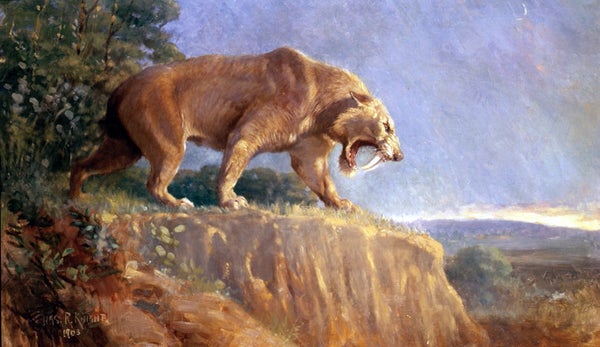Modern pantherine cats—such as leopards, tigers and lions—can roar because of a very specialized setup of small throat bones and ligaments that form part of their larynx, or voicebox. Now paleontologists have found similar fossilized bones that belonged to the prehistoric saber-toothed cat, Smilodon fatalis, suggesting it emitted fearsome vocalizations.
Finding such small fossils is rare, but in this case was made possible by the unusual preservation in asphalt seeps at Rancho La Brea in Los Angeles. Here the entire skeletons of animals such as Smilodon are often frequently preserved, says paleontologist Christopher Shaw of the Idaho Museum of Natural History, who presented the discovery Saturday at the Society of Vertebrate Paleontology meeting in Albuquerque, New Mexico.
Among the millions of fossils recovered to date at Ranch La Brea—which date back to between 11,000 and 40,000 years ago—are about 166,000 bones of Smilodon. These include 150 narrow, one- to four-inch-long bones, which Shaw now reports were part of the primitive cat’s “hyoid arch” or larynx. Shaw’s late colleague Antonia Tejada-Flores found a cigar box full of disconnected hyoid bones of various animals in the basement of the Natural History Museum of Los Angeles County in the 1970s. “Antonia worked out that based on the proportions of the material and the number of bones, they belonged to the saber-toothed cat, Smilodon, which is the second most common large mammal found at Rancho La Brea” after dire wolves, Shaw says.
On supporting science journalism
If you're enjoying this article, consider supporting our award-winning journalism by subscribing. By purchasing a subscription you are helping to ensure the future of impactful stories about the discoveries and ideas shaping our world today.
Shaw has only recently completed a detailed study of the fossils, showing there were five bones in the complex hyoid arch of Smilodon, similar to that of modern roaring cats. Today’s big felines have one of two styles of hyoid arches, which anchor both the larynx and extensions of the tongue to the throat. One style is composed of nine to 11 bones and is found in species that purr but cannot roar. The second style—found in cats that can roar but not purr— is composed of five bones, with an elastic ligament between two of them.
When a lion wants to roar, it opens its mouth and “this ligament stretches from about six to about nine inches, giving it the ability to widen the throat and make a deeper tone,” says Shaw. Based on the fossils, Smilodon had a very similar arrangement of bones in its hyoid arch, he adds. “Our conclusion is that Smilodon had the capability of roaring. If it did in fact roar, it would [have been] an important communication device.”
Modern big cats roar to communicate both within and between species, and the ability is also important in social or pack animals. Some previous findings suggested Smilodon was a gregarious animal, Shaw says, and “this is a provocative new piece of evidence that might support social behavior.”
Blaire Van Valkenburgh, an expert on fossil carnivores at the University of California, Los Angeles, who was not involved in the study, says roaring would also be consistent with Smilodon having had complex social behavior or being a pack hunter. “If they were communicating through roaring, that would be typical of a social species,” she says. “The discovery that Smilodon probably had a roaring repertoire and apparatus is interesting in that it suggests that roaring evolved independently in both the sabertooth lineage and the modern large cat lineage, given that they last shared a common ancestor at least 39 million years ago.”
Shaw agrees the more complex set up of 9 to 11 hyoid bones seen in purring cats is likely to be the ancestral condition for the family Felidae, which includes Smilodon and its relatives alongside all modern cats, and that the adaptation that allowed roaring evolved on separate occasions in the ancestors of both Smilodon and living pantherine cats. Perhaps the two groups shared the genes that allowed the change to be possible, he speculates.
Ashley Reynolds, an expert on fossil cats at the University of Toronto, says the finding is very interesting, but warns it may not be entirely conclusive, as snow leopards today have the same kind of larynx as other pantherine cats, but do not roar. “It’s not a direct one-to-one relationship between having that ligament and being able to roar, but it’s certainly interesting to think that Smilodon may have had that ability,” she says.
